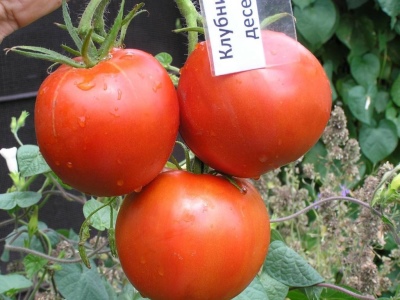
- Authors: Gavrish S.F., Morev V.V., Amcheslavskaya E.V., Degovtsova T.V., Volok O.A., Vasilyeva M. Yu. (LLC "Gavrish Breeding Firm")
- Year of approval: 2019
- Category: grade
- Growth type: indeterminate
- Appointment: fresh consumption, for juice, for ketchup and tomato paste
- Ripening period: mid-season
- Ripening time, days: 110-120
- Growing conditions: for film greenhouses, for greenhouses
- Bush size: tall
- Bush height, cm: more than 200
Tomato variety Strawberry Dessert can be grown in greenhouse structures or outdoors under a film covering. Plants are indeterminate. Their leaves are of medium length, their color is dark green.
Description of the variety
This type is most often used in the preparation of various salads, sauces, tomato pastes, juices, you can use ripe fruits and fresh. This variety allows you to get a fairly bountiful harvest. It was released for use in 2019.
The variety is considered to be quite stress-resistant. It is rarely affected by insects and diseases. Strawberry dessert has a light and pleasant aroma, good taste.
The main qualities of the fruit
Unripe vegetables are green with a dark green spot. Ripe tomatoes are bright red in color. Their shape is round, slightly ribbed.
All fruits are rather large in size. The mass of one vegetable is approximately 230-270 grams.
Their flesh is fleshy, juicy and dense, with few seeds. The skin on tomatoes is rather thin and tender.
Taste characteristics
Tomato variety Strawberry dessert has excellent taste characteristics, so it is also used in the preparation of ketchups, sauces, salads and many other dishes.
Ripening and fruiting
Strawberry dessert is a mid-season variety. It matures approximately 110-120 days after planting outdoors. Harvesting is usually in July-August.
Yield
This variety of tomatoes is considered to be high yielding. From 1 square meter, it will be possible to collect about 9.5-10 kilograms of ripe fruits.
The timing of planting seedlings and planting in the ground
Sowing seedlings is best done at the end of March. You can plant young plants in greenhouses or in open ground in late April or early May.

Growing tomato seedlings is an extremely important process, because it largely depends on whether the gardener will be able to harvest at all. All aspects must be taken into account, from seedbed preparation to planting in the ground.
Landing scheme
Plants are planted according to the scheme 40x60 cm.

Growing and care
To sow seedlings, you should prepare containers for this. You can use simple disposable plastic cups. The soil is also prepared separately, it is better to mix it with peat right away, you can add a little other nutritional components.
After that, the earth is carefully distributed over all containers. Small grooves are made on the surface, seeds will be laid in them. It is not recommended to deepen them too much.From above, all this can be covered with a small amount of earthen mixture.
Many gardeners recommend pre-carefully treating all seed material with special fungicides. Such substances will further protect the vegetation from the invasion of insects and from various diseases.
You will need to store containers with seed in a dry place at room temperature. When 2-3 small leaves appear, the seedlings dive.
When transplanting into a greenhouse or into open ground, you first need to form planting holes, observing the distance between individual bushes (55-60 cm) and between rows (65-70 cm). At the same time, fertilizers can be applied to the ground immediately. Often, a solution with a mullein is used for this, you can take ready-made store dressings.
Plants need to be planted as carefully as possible so as not to damage their root system. Planting is carried out together with an earthen clod on the roots. Immediately after planting, the soil around the seedlings should be watered with plenty of clean water.
If you are landing in open ground on a land plot, then it is better to use a special film cover. It will help protect plants from adverse environmental influences.
Such tomato bushes are unpretentious. For the full development of the bushes, it will be necessary to perform regular watering, their number is reduced in rainy periods.
You will also need to make nutritional supplements. You can use ready-made complex fertilizers, mineral and organic compounds. Sometimes gardeners use folk tinctures with wood ash, iodine, and garlic.
This variety is tall, so it must be tied to a trellis or to another strong supporting structure. In addition, it needs pinning.




A plant needs different micronutrients at each stage of growth. All fertilizers can be divided into two groups: mineral and organic. Folk remedies are often used: iodine, yeast, bird droppings, eggshells.
It is important to observe the rate and period of feeding. This also applies to folk remedies and organic fertilizers.
Disease and pest resistance
Tomato variety Strawberry dessert is quite resistant to diseases, including viral ones. It is practically not susceptible to late blight, from which many other varieties suffer.
For the prevention of fungal diseases, it is recommended to carry out treatments using solutions with potassium permanganate or copper sulfate. You can periodically perform spraying with special biological preparations that have an anti-fungal effect.
At the time of fruiting, the variety can be affected by slugs. Delete them manually. To scare off such pests, you can use a solution with ammonia. You will also need to cover the ground well with a thick layer of peat or straw.This will protect the vegetation from root rot.



























































































